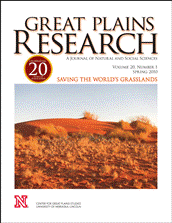Center for Great Plains Studies

Great Plains Research: A Journal of Natural and Social Sciences (through 2013)
Date of this Version
Spring 2000
Document Type
Article
Abstract
The Nebraska Sand Hills region is a giant dune field that is presently stabilized by prairie vegetation. During numerous severe droughts within the last 15,000 years, the dunes have lost their plant cover and have migrated freely. Wetlands between dunes are extensive in the central Sand Hills and are connected to the High Plains (Ogallala) aquifer. Lakes and wetlands were formed when dunes blocked and deranged stream systems. Evaporation of water from wetlands may benefit adjacent dune vegetation during extended droughts, by locally increasing humidity and rainfall. Buried bison tracks are abundant within the dunes, suggesting that grass and water remained available in some interdunes, even during episodes of dune migration. Study of the geologic processes operating within this dune field enhances not only our ability to read the paleoclimatic history of the Great Plains, but also our understanding of features found within similar deposits from the rock record.


Comments
Published in Great Plains Research 10 (Spring 2000): 5-35. Copyright © 2000The Center for Great Plains Studies, University of Nebraska–Lincoln. Used by permission. http://www.unl.edu/plains/publications/GPR/gpr.shtml